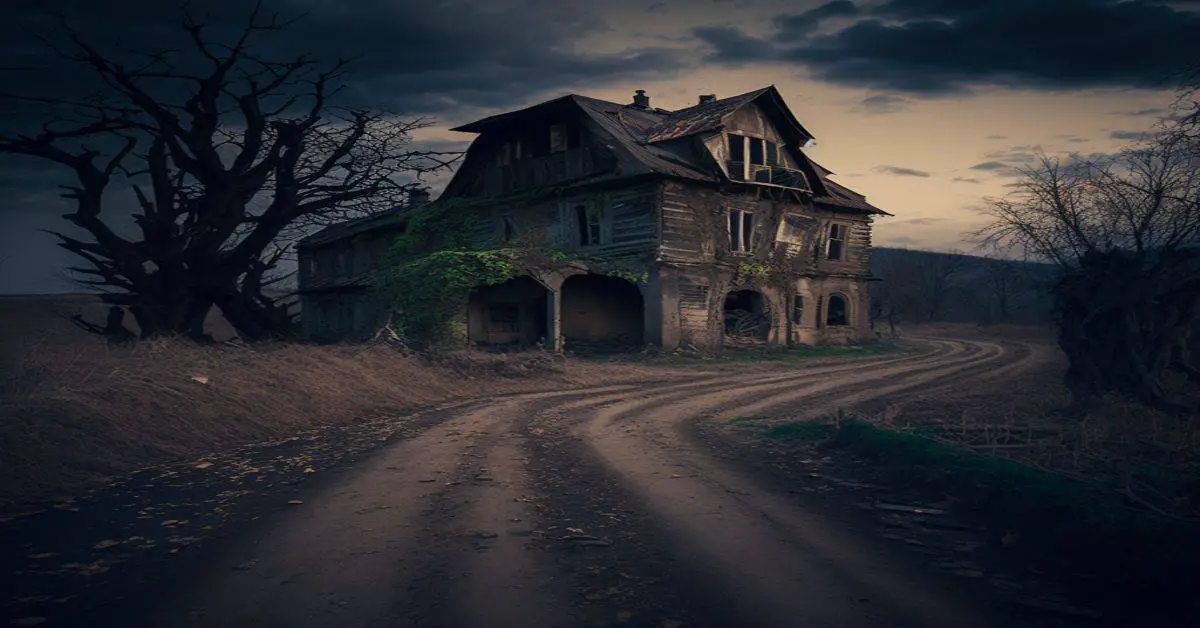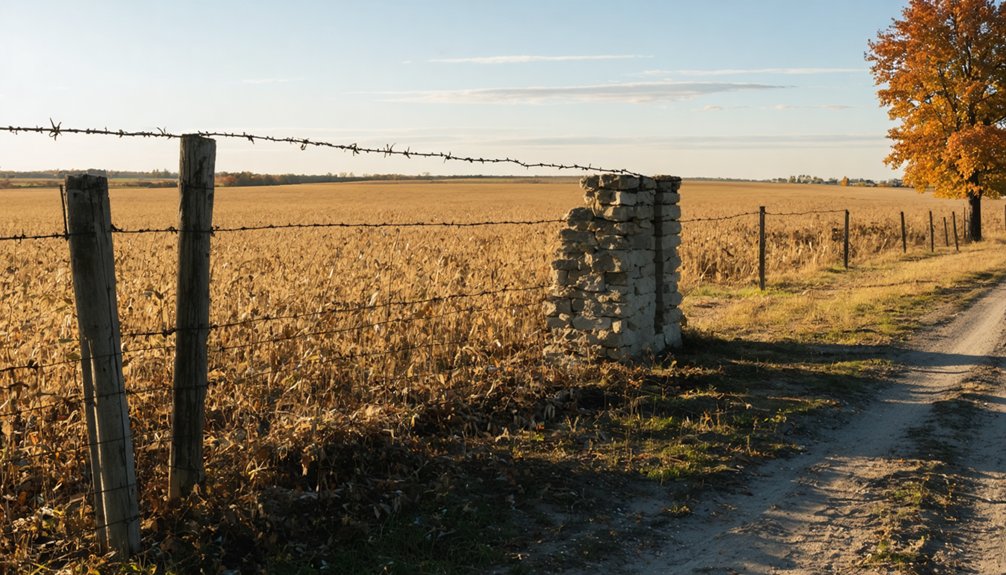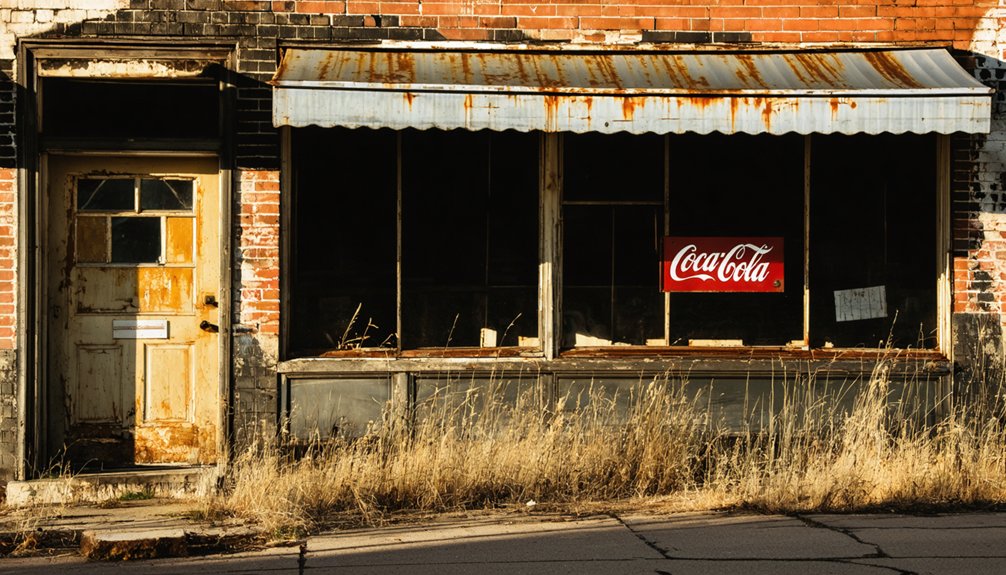You’ll find Hagaman’s weathered remains 4 miles southwest of Hettick, Illinois, where only 10 residents remain today. This former railroad boomtown along the Chicago, Peoria & St. Louis line once bustled with nearly 100 people, centered around Robinson’s General Store – the town’s social hub and first building with electricity. The abandoned structures and original hitching post at the general store tell fascinating tales of pioneer life in late 1800s Macoupin County.
Key Takeaways
- Hagaman, Illinois transformed from a thriving railroad community of nearly 100 residents to a ghost town with only 10 people today.
- Located 4 miles southwest of Hettick, Hagaman features weathered historical structures including the iconic Robinson’s General Store.
- The town’s decline stemmed from rural exodus, school consolidation, and changing economic conditions following its railroad-era prosperity.
- Robinson’s General Store, which served as a post office and community hub, remains a preserved testament to 19th-century pioneer life.
- Visitors can explore the ghost town’s historical remnants, though decaying structures and uneven terrain present safety considerations.
The Rise of a Rural Midwestern Settlement
As French explorers ventured into Illinois during the 17th century, they encountered the indigenous Illinoisan people along Macoupin Creek, where Hagaman would later emerge as a distinctive rural settlement.
Native tribes along Macoupin Creek first encountered French voyageurs exploring Illinois, long before Hagaman’s rural identity took shape.
The region’s settlement origins took shape as pioneers pushed northeast from the Mississippi River, establishing roots in Macoupin County’s fertile soil. German ancestry dominated the area’s demographic makeup as settlers established their homesteads.
You’ll find Hagaman’s transformation gained momentum in the mid-to-late 19th century when railroad development revolutionized local prospects.
The Chicago, Peoria & St. Louis railway line and another major rail route connected the growing town to larger economic centers.
The agricultural practices that once sustained isolated homesteaders now connected to broader markets, as rail lines positioned the community between St. Louis and Springfield.
This strategic location spurred remarkable growth for such a small population, with C.C. Robinson’s 1881 general store symbolizing the town’s evolution from subsistence farming to a connected rural hub.
Life in 19th Century Hagaman
You’d find farmers and townsfolk gathering daily at J.L. Robinson’s General Store, where they’d trade crops for household goods while catching up on local news at the hitching post.
The store’s dual role as post office and railway express office made it the hub of Hagaman’s farm-to-market network, connecting local producers to Chicago and St. Louis merchants. Being the first with electricity in the area, the store became a symbol of progress for the rural community.
When neighbors weren’t conducting business, they’d come together at the town hall or church for community functions, with the three venues forming the backbone of Hagaman’s social fabric.
Daily Store Interactions
Three distinct types of daily interactions animated life at the Hagaman General Store in the 1880s: essential commerce, postal services, and political discourse.
You’d find store clientele gathering around the wood stove, discussing local affairs while waiting to purchase household goods or farming supplies. Like their Dutch ancestors’ thrift, community members carefully managed their purchases, tracking each penny spent. Transaction dynamics centered on the period-authentic meat counter and shelves stocked with necessities like stiff shirt collars.
As the first building with electricity and telephone service, you’d stop by to collect your mail or send packages via the railway express office.
The store’s role as Democratic Party headquarters meant you’d likely engage in political debates with neighbors, making it more than just a mercantile – it was where you’d connect with your community of 93 residents through daily rituals of rural life.
Farm-to-Market Trading Networks
Beyond the bustling Hagaman General Store, an intricate web of trading networks connected local farmers to national markets.
You’d find your grain transport options expanding dramatically after 1848, when the Illinois-Michigan Canal opened new routes to Chicago’s burgeoning marketplace. No longer were you bound to local storekeepers’ monopolies or slow flatboat shipping.
Your market access improved further as railroads crisscrossed the prairie, letting you bypass traditional middlemen. You could ship your grain to Chicago’s massive elevators, where merchants graded and priced your crops based on quality standards used in Buffalo, New York City, and even London.
This new freedom meant better prices and more buyers for your harvest, though you’d still need to navigate the merchants’ superior knowledge of transport costs and endpoint market prices. The development of standardized contracts helped farmers better understand their trading terms and obligations. Like many farmers of the era, you likely maintained a balance between market needs while deciding what to plant and raise on your land.
Community Social Gatherings
Life in nineteenth-century Hagaman revolved around vibrant social gatherings that defined the town’s communal spirit.
You’d find the church at the heart of local social traditions, hosting regular services and community events that brought families together. The general store buzzed with daily activity as residents shared news while picking up supplies and mail at the adjacent post office.
The town hall served as another cornerstone of civic life, where you’d participate in dances, celebrations, and important community decisions. Hotels welcomed travelers and hosted social dinners, while the railroad depot became a natural meeting spot as trains arrived four times daily. Similar to the popular Capital Hotel at Vishnu Springs, these establishments were vital social spaces where residents could gather and connect.
These gathering places wove together Hagaman’s social fabric, creating bonds that sustained this small community of 30-40 residents through their daily lives.
The Legacy of Robinson’s General Store
You’ll find Robinson’s General Store was more than just a mercantile establishment – it served as the beating heart of daily commerce in 19th century Hagaman.
Within its weathered walls, locals gathered not only to purchase essential goods but also to collect their mail, as the store functioned as the community’s postal hub until 1899. The store owner maintained his postmaster position after being originally appointed by Garfield.
The store’s dual role as merchant and post office cemented its place as the social nucleus of this small Illinois railroad town during its heyday. Much like how E. Linney served as the first postmaster when Concordia’s post office opened in 1870, Robinson’s played a vital role in connecting the community through postal services.
Heart of Daily Commerce
At the center of Hagaman’s vibrant past stood Robinson’s General Store, a cornerstone of daily commerce since 1881 when railroad worker C. C. Robinson established this enduring business.
You would’ve found everything from essential groceries to farming supplies in the store inventory, making it indispensable to the town’s 93 residents.
The store’s success thrived on strong customer relationships, serving as both a trading post and community hub where locals gathered to exchange news and goods.
Like the historical employee-owned business model established by Henson C. Robinson’s company in Springfield, Robinson’s General Store fostered a deep connection with its community.
In a town with three grocery stores, Robinson’s distinguished itself through personalized service and a diverse selection of merchandise.
Even today, you’ll find the store maintaining its turn-of-the-century charm, complete with an original hitching post and traditional products that harken back to Hagaman’s railroad boom days.
Postal Hub Until 1899
Through its role as Hagaman’s primary postal outlet, Robinson’s General Store became an irreplaceable communication hub for local residents until 1899.
The store’s strategic position near rail lines made it the nexus of postal services and communication networks, with John W. Robinson serving as deputy postmaster.
- You’d find your mail delivered via the store’s efficient rail-synchronized distribution system
- The store served as your only connection point for sending and receiving packages
- Before telephones, you’d rely on the store for all essential communications
- Your local news and information would flow through this central gathering spot
- You could count on the store’s postal services to connect you with the outside world
The store’s dual function as postal hub and general store created a crucial lifeline for Hagaman’s 93 residents and surrounding rural families.
From Bustling Village to Abandoned Town
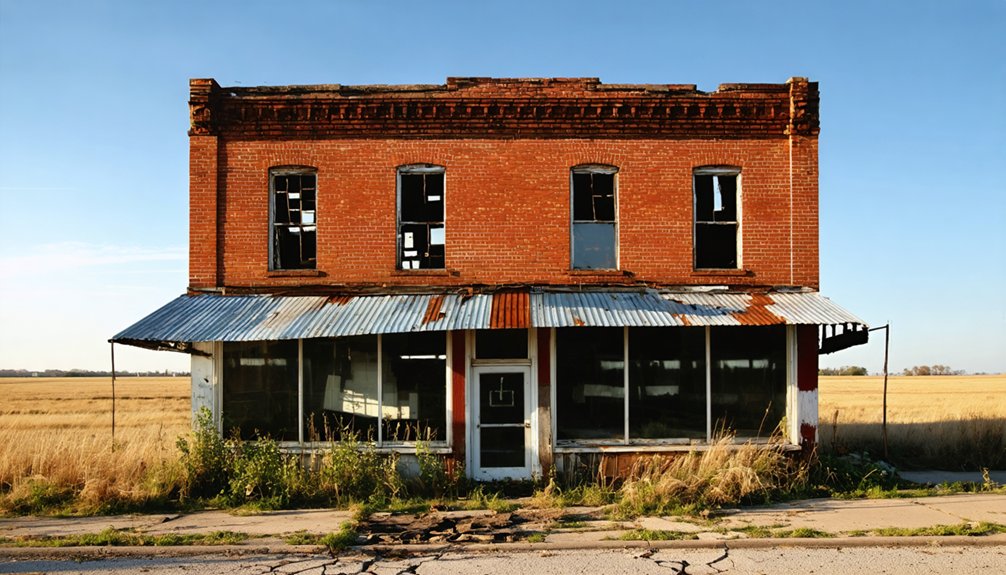
Once a thriving community in Macoupin County, Hagaman transformed from a bustling village of nearly 100 residents into a near-ghost town with just 10 people today.
Economic shifts and demographic trends took their toll on this railroad town, which once boasted two rail lines, multiple grocery stores, and a hotel.
You’ll find remnants of Hagaman’s prosperous past in its surviving structures. The general store, opened in 1881, remains in the hands of its original family. The town hall and church still stand as silent witnesses to a bygone era.
While three creeks continue to flow through the area, the post-WWII rural exodus and school consolidation contributed to the town’s decline. Like many small Illinois communities, Hagaman couldn’t resist the pull of urbanization that drew residents to larger cities.
Exploring the Remnants Today
Visitors exploring Hagaman today will find a haunting tableau of pioneer life frozen in time. Located 4 miles southwest of Hettick, this ghost town exploration reveals the raw beauty of rural Illinois history.
Step back in time at Hagaman, where echoes of pioneer life linger in this forgotten Illinois ghost town.
You’ll discover weathered structures and architectural remnants that tell stories of 19th-century frontier life.
- Crumbling brick foundations and wooden frames showcase original pioneer building techniques
- Overgrown paths wind through abandoned homesteads, now reclaimed by nature
- Historical artifacts occasionally surface, offering glimpses into daily frontier living
- No modern facilities exist – you’re experiencing history in its untamed state
- Local historians document the site’s historical significance through photographs and stories
Exercise caution during your visit – decaying structures and uneven terrain present real hazards.
Wear sturdy boots and bring your camera to capture this remarkable piece of Illinois heritage.
Preserving Memories of a Lost Community
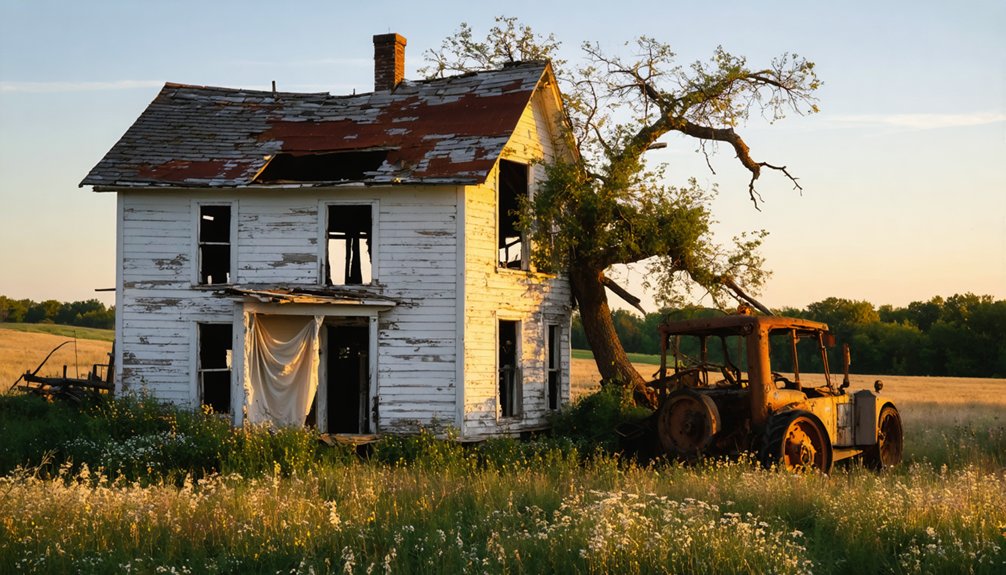
While physical remnants tell part of Hagaman’s story, the town’s rich legacy lives on through dedicated preservation efforts.
You’ll find the community nostalgia woven into oral histories passed down by former residents and their descendants, who maintain strong connections to this once-thriving pioneer settlement. The Hagaman General Store, still standing with its original meat counter and weathered porch, serves as a tangible link to the past.
Local historical societies work tirelessly on historical preservation, documenting family histories and artifacts through digital archives.
They’ve preserved accounts of the railroad’s significance, stories of mule-driven construction, and memories of daily life in this 19th-century rural Illinois community.
Through these combined efforts, you can still experience Hagaman’s heritage as more than just another ghost town.
Frequently Asked Questions
Are There Any Documented Paranormal Activities or Ghost Sightings in Hagaman?
You won’t find documented haunted locations or ghost encounters in Hagaman. Unlike other Illinois ghost towns, historical records and local accounts don’t mention any paranormal activity around its abandoned structures.
What Were the Highest Recorded Population Numbers During Hagaman’s Peak Years?
Even with Instagram’s absence back then, you can’t find exact population records, but historical significance suggests population trends peaked between 200-1,000 residents based on similar regional village patterns.
Did Any Notable Historical Figures Ever Visit or Stay in Hagaman?
You won’t find evidence of any notable historical figures visiting Hagaman in the records. Despite its regional significance as a pioneer settlement, there’s no documentation of prominent visitors staying there.
Were There Any Churches or Schools Established in the Town?
You won’t find documented church history or school legacy there – historical records don’t confirm any established churches or schools. Residents likely traveled to nearby towns for worship and education.
What Happened to the Town’s Cemetery and Burial Records?
You’ll find multiple preserved cemeteries like Crossland and St. Catherine’s still exist, with burial records maintained through family plots, online databases, and genealogical societies, though some records remain fragmented.
References
- https://illinoisstateonline.com/ghost-towns-in-illinois/
- https://www.youtube.com/watch?v=93k0qtvzkn4&vl=en-US
- https://sangamoncountyhistory.org/wp/14696/
- http://livinghistoryofillinois.com/pdf_files/History of Macoupin County
- https://www.ghosttowns.com/states/il/hagaman.html
- https://storymaps.arcgis.com/stories/6ea7c4b9b0594c039c2792d5be7456c9
- https://en.wikipedia.org/wiki/List_of_ghost_towns_in_Illinois
- https://macoupin.illinoisgenweb.org/history/hagamanstore.html
- https://dnrhistoric.illinois.gov/research/sitepages/timeline.html
- https://en.wikipedia.org/wiki/Macoupin_County

